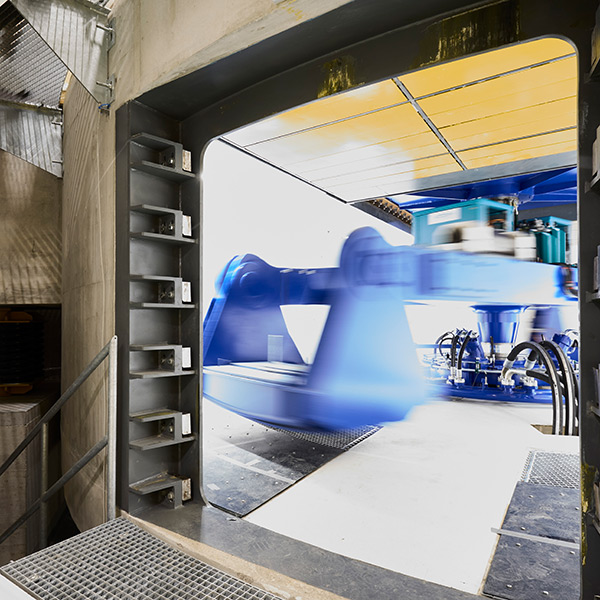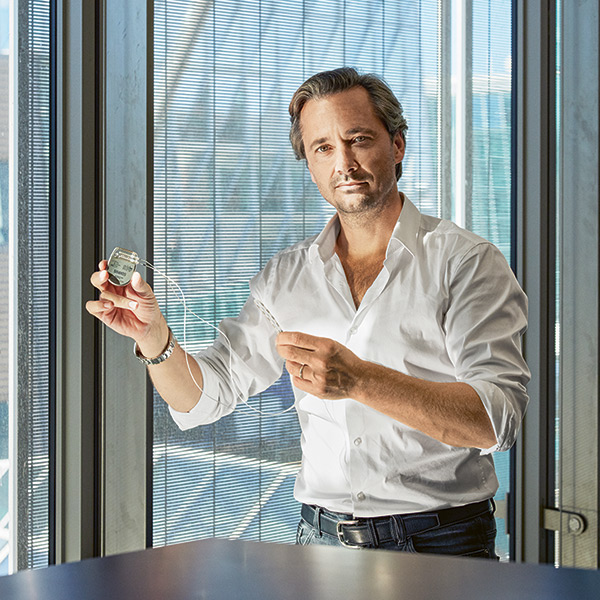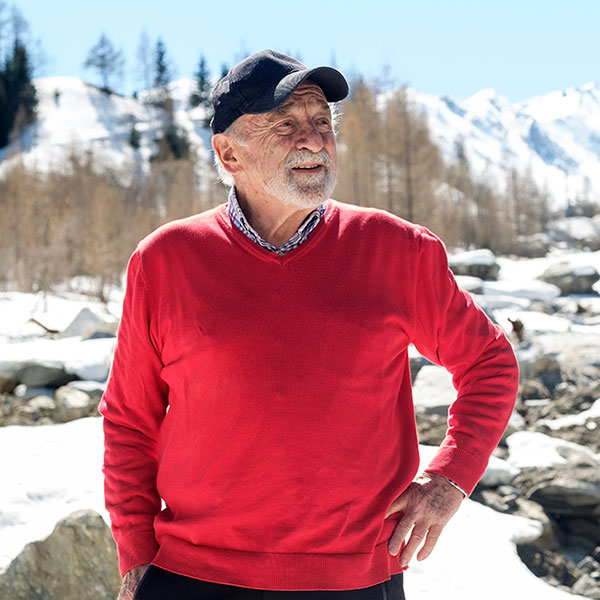The fun and fascination of science
The National Competition by ‘Swiss youth in science’ gives many high-school students their first contact with the world of science.
Painting the temperature
Based on the principle that light-coloured clothing cools the body but dark colours warm it, Steve Joseph and his classmates Ladina Fontana and Leonardo Rössler at the high school Berufsmittelschule Winterthur have been working on a paint recipe using thermochromic pigments. From a certain temperature upwards, the colour should change from dark to light, and the rays of the sun will no longer be turned into heat, but reflected back. This would allow buildings to regulate their inside temperature solely through changing colour, without needing any additional energy. The three young researchers tested their mixture on a car and measured the temperature changes with a thermal imaging camera. “On my own, I certainly wouldn’t have done so well in the competition”, says Joseph. It was the teamwork that made the difference. At 27 degrees, the colour changed from dark to light. All it lacks is a finishing touch. If it’s to be used in industrial applications, they will first have to work on improving its weather resistance.

Photo: Valérie Chételat/Prizes for young Swiss scientists
Name: Steve Joseph
Age: 20
Location: Herrbrugg, St. Gallen
Studies: Chemistry at the Zurich University of Applied Sciences ZHAW
Role model: Elon Musk
Monitoring renaturation
Arianna Arpagaus seized the moment. When the Cassarate River behind her high school was being renaturised, she decided to monitor the process. So she acquired the necessary sensors and got out her magnifying glass and her pen and notebook. “The most valuable results are the ones you can see – and in the best cases, they’re positive”, says this passionate young biologist. In the summer of 2015, Arpagaus took three sets of samples from her river, moving on to analyse the types of microbes in it, describe the course of the river, and measure the water quality. Practical results confirmed the theory: downriver from the urban areas, the indicators decreased in number. “I could see with my own eyes that the renaturisation work has a positive impact”. The signs of this are still not very clear, but the water quality is generally high, while the low concentration of pollutants and the biological indicators point to a river that is healthy overall.

Photo: Valérie Chételat/Prizes for young Swiss scientists
Name: Arianna Arpagaus
Age: 20
Location: Castagnola, Ticino, and Zurich
Studies: Health sciences at ETH Zurich
Role model: Nino Schurter, professional mountain biker
Tracing memories
Maria Grazia Mansour – who has since embarked on medical studies – wanted to investigate human powers of recall, and so set up her own ‘lab’ in the bomb shelter underneath her high school. She placed three key objects in the room: a grandfather clock, incense and a plant. The one ticked, the next exuded a scent, and the third simply stood there. For her experiment, Mansour took 82 of her peers into the room for two minutes, then made them leave. They then had to fill out a Sudoku puzzle, during which time she re-entered the room to alter some aspect of the objects in it. She then took her test subjects back into the room, and afterwards tested their powers of recall by means of a questionnaire, asking whether anything in the room had changed its place. Roughly a third of the participants noticed when the clock or the incense had been moved. Only one in fifteen noticed if she had moved the plant. Her analysis of the results showed that linking visual stimuli with smells or sounds serves to improve one’s powers of recall, but the opposite is not the case.

Photo: Valérie Chételat/Prizes for young Swiss scientists
Name: Maria Grazia Mansour
Age: 19
Location: Bussigny, Vaud
Studies: Medicine at the University of Lausanne
Role models: Doctors – I’d like to become one too, one day.
The drug revolution
Laura Peter sifted through no less than 10,000 historical documents for her brilliantly researched final project at high school, entitled ‘Breaking the deadlock with survival support: the drug policies of the Zurich City Council from 1989 to 1995’. It had its beginnings in the exchange year that she spent in Vancouver. “It was there that I discovered how the Canadian authorities oriented their drug policy on the Zurich model. This was a topic that I hardly knew anything about”. The extant literature wasn’t able to still her thirst for more knowledge. So, with the permission of the Zurich City Archives, she plunged into the world of primary sources. Her conclusion was this: “What had begun as a revolutionary measure against misery and hardship became the new norm, and is a guarantee today that there won’t be an open drug scene any more”. Peter also sees her work as possible inspiration for other cities to apply the Zurich model. “If this knowledge is adapted to local circumstances in other places, big things are possible”.

Photo: Valérie Chételat/Prizes for young Swiss scientists
Name: Laura Peter
Age: 19
Location: Küsnacht, Zurich
Studies: Humanities
Role models: People who pursue unpopular things and take on responsibility in society.
The future of transplants
When transplanting limbs, immunosuppressive drugs are currently applied to the whole body. This can have major side-effects. So Lorina Locher wanted to know whether the body’s rejection reaction can also be inhibited by means of local immunosuppressants. In collaboration with the Department for BioMedical Research at the University of Bern, she used rat models to carry out her research. Locher analysed two methods, which she says “only represent a fraction of a larger-scale research project, but could still help limb transplants to become a more broad-based, routine procedure”. This was great news. “What was also great was finding out that I was able to develop a research question of such complexity, solve it and actually understand it, completely independently”. According to the experts, this work marks the beginning of a scientific career. The objective manner in which she procured her results and interpreted them with a view to further research, they say, is “proof of a great understanding of research in the natural sciences”.

Photo: Valérie Chételat/Prizes for young Swiss scientists
Name:</strong Lorina Locher
Age: 21
Location: Wohlen, Aargau
Studies: Machine engineering at ETH Zurich
Role models: Elon Musk and people who want to change the world
Let there be light
Caroline Hasler’s high-school project on the luminescence of Ba7F12CL2:Eu2+ is as impressive as it is promising: she took a kaleidoscopic jumble of measurements and hypotheses and turned them into a meaningful piece of work on a par with the experimental section of a Master’s thesis, with a view to its later expansion and publication. She was fascinated by the physical reasons for luminescence and its technological applications, and so she began to explore them in a laboratory of the Department of Physical Chemistry at the University of Geneva. At the same time, she investigated how fluorescent materials are tested for their commercial potential. “It was a highly exciting time, and produced results that were just as exciting”, says Hasler. Her experiments did not just comprise collecting information on the future optimisation of the florescent material she was analysing. She also happened upon an interesting discrepancy. “According to my measurements, the luminescence of Ba7F12CL2:Eu2+ could involve another mechanism, one different from what the theoretical model has presupposed up to now”. To be continued…

Photo: Valérie Chételat/Prizes for young Swiss scientists
Name: Caroline Hasler
Age: 19
Location: Aargau
Studies: Classical history and Latin in Rome. Physics at ETH Zurich (2018).
Role model: Richard Feynman, US physicist and Nobel Laureate 1965
Data trainer
Raphael Husistein’s foray into the future of data research didn’t just result in a brilliant high-school project, but also an invitation to the 2018 Taiwan International Science Fair. “I’m really looking forward to being able to converse with international experts again over there”, says Husistein. “Being able to do so while working on my high-school project was something I really found enriching”. His project was entitled ‘Realising number recognition with an artificial neural network’. In it, he investigated how to employ artificial neural networks to combat overfitting and the overuse of random access memory (RAM). The big media response to Google’s DeepDream was what awakened Raphael Husistein’s curiosity. “From that moment on, I really wanted to learn more about how this technology functions”. Even though the performance he achieved was not greater than that of conventional neural networks, Husistein’s research still resulted in new findings. “In future experiments, the most important thing is to determine the conditions that will be necessary for preconnected Kohonen Networks to bring about an improvement”. This young researcher obviously isn’t lacking in research topics for the future.

Photo: Valérie Chételat/Prizes for young Swiss scientists
Name: Raphael Husistein
Age: 19
Location: Beckenried, Nidwalden
Studies: Computational Sciences at ETH Zurich
Role model: Bill Gates




